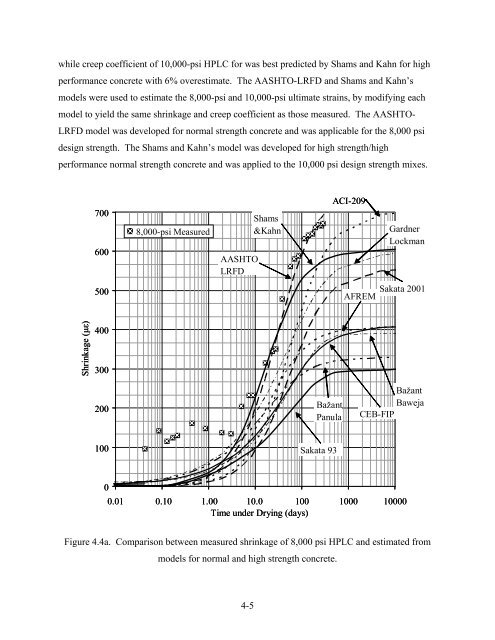Lightweight Concrete for High Strength - Expanded Shale & Clay
Lightweight Concrete for High Strength - Expanded Shale & Clay
Lightweight Concrete for High Strength - Expanded Shale & Clay
You also want an ePaper? Increase the reach of your titles
YUMPU automatically turns print PDFs into web optimized ePapers that Google loves.
while creep coefficient of 10,000-psi HPLC <strong>for</strong> was best predicted by Shams and Kahn <strong>for</strong> high<br />
per<strong>for</strong>mance concrete with 6% overestimate. The AASHTO-LRFD and Shams and Kahn’s<br />
models were used to estimate the 8,000-psi and 10,000-psi ultimate strains, by modifying each<br />
model to yield the same shrinkage and creep coefficient as those measured. The AASHTO-<br />
LRFD model was developed <strong>for</strong> normal strength concrete and was applicable <strong>for</strong> the 8,000 psi<br />
design strength. The Shams and Kahn’s model was developed <strong>for</strong> high strength/high<br />
per<strong>for</strong>mance normal strength concrete and was applied to the 10,000 psi design strength mixes.<br />
700<br />
600<br />
8,000-psi Measured<br />
Shams<br />
&Kahn<br />
AASHTO<br />
LRFD<br />
ACI-209<br />
Gardner<br />
Lockman<br />
500<br />
Sakata 2001<br />
AFREM<br />
Shrinkage (µε)<br />
400<br />
300<br />
200<br />
Bažant<br />
Panula<br />
Bažant<br />
Baweja<br />
CEB-FIP<br />
100<br />
Sakata 93<br />
0<br />
0.01 0.10 1.00 10.0 100 1000 10000<br />
Time under Drying (days)<br />
Figure 4.4a. Comparison between measured shrinkage of 8,000 psi HPLC and estimated from<br />
models <strong>for</strong> normal and high strength concrete.<br />
4-5















